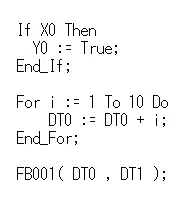Texte structuré
Le texte structuré, ou Structured Text (ST) en anglais, est un des cinq langages de programmation pour automates programmables industriels (API) définis par la norme CEI 61131-3. C'est un langage de haut niveau et sa structure rappelle les langages Ada et Pascal.

Exemple de programme structuré
Le format de ces fichiers a été standardisé en XML par PLCopen.
Des instructions plus ou moins complexes sont supportées, par exemple :
- boucles d'itération (REPEAT-UNTIL; WHILE-DO; FOR) ;
- conditions (IF-THEN-ELSE; CASE) ;
- fonctions (SQRT(); SIN()).
Exemple de programme
(* simple state machine *)
TxtState := STATES[StateMachine];
CASE StateMachine OF
1: ClosingValve();
ELSE
;; BadCase();
END_CASE;
Autre exemple de programmation ST
// PLC configuration
CONFIGURATION DefaultCfg
VAR_GLOBAL
b_Start_Stop : BOOL; // Global variable to represent a boolean.
b_ON_OFF : BOOL; // Global variable to represent a boolean.
Start_Stop AT %IX0.0:BOOL; // Digital input of the PLC (Address 0.0)
ON_OFF AT %QX0.0:BOOL; // Digital output of the PLC (Address 0.0). (Coil)
END_VAR
// Schedule the main program to be executed every 20 ms
TASK Tick(INTERVAL := t#20ms);
PROGRAM Main WITH Tick : Monitor_Start_Stop;
END_CONFIGURATION
PROGRAM Monitor_Start_Stop // Actual Program
VAR_EXTERNAL
Start_Stop : BOOL;
ON_OFF : BOOL;
END_VAR
VAR // Temporary variables for logic handling
ONS_Trig : BOOL;
Rising_ONS : BOOL;
END_VAR
// Start of Logic
// Catch the Rising Edge One Shot of the Start_Stop input
ONS_Trig := Start_Stop AND NOT Rising_ONS;
// Main Logic for Run_Contact -- Toggle ON / Toggle OFF ---
ON_OFF := (ONS_Trig AND NOT ON_OFF) OR (ON_OFF AND NOT ONS_Trig);
// Rising One Shot logic
Rising_ONS := Start_Stop;
END_PROGRAM
Exemple de déclaration d'un bloc fonctionnel
//=======================================================================
// Function Block Timed Counter : Incremental count of the timed interval
//=======================================================================
FUNCTION_BLOCK FB_Timed_Counter
VAR_INPUT
Execute : BOOL := FALSE; // Trigger signal to begin Timed Counting
Time_Increment : REAL := 1.25; // Enter Cycle Time (Seconds) between counts
Count_Cycles : INT := 20; // Number of Desired Count Cycles
END_VAR
VAR_OUTPUT
Timer_Done_Bit : BOOL := FALSE; // One Shot Bit indicating Timer Cycle Done
Count_Complete : BOOL := FALSE; // Output Bit indicating the Count is complete
Current_Count : INT := 0; // Accumulating Value of Counter
END_VAR
VAR
CycleTimer : TON; // Timer FB from Command Library
CycleCounter : CTU; // Counter FB from Command Library
TimerPreset : TIME; // Converted Time_Increment in Seconds to MS
END_VAR
// Start of Function Block programming
TimerPreset := REAL_TO_TIME(in := Time_Increment) * 1000;
CycleTimer(
in := Execute AND NOT CycleTimer.Q
,pt := TimerPreset);
Timer_Done_Bit := CycleTimer.Q;
CycleCounter(
cu := CycleTimer.Q
,r := NOT Execute
,pv := Count_Cycles);
Current_Count := CycleCounter.cv;
Count_Complete := CycleCounter.q;
END_FUNCTION_BLOCK
Lien
Cet article est issu de wikipedia. Text licence: CC BY-SA 4.0, Des conditions supplémentaires peuvent s’appliquer aux fichiers multimédias.